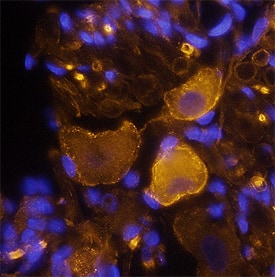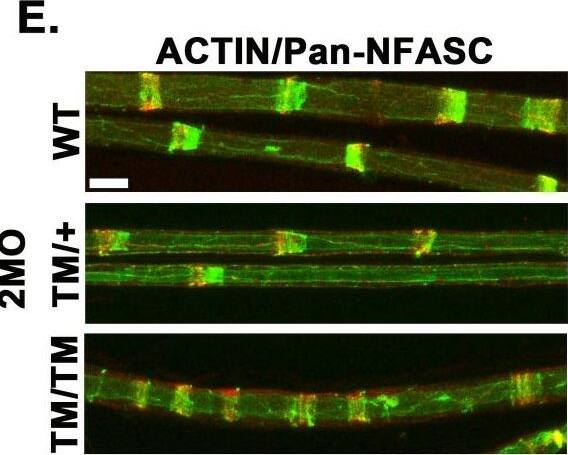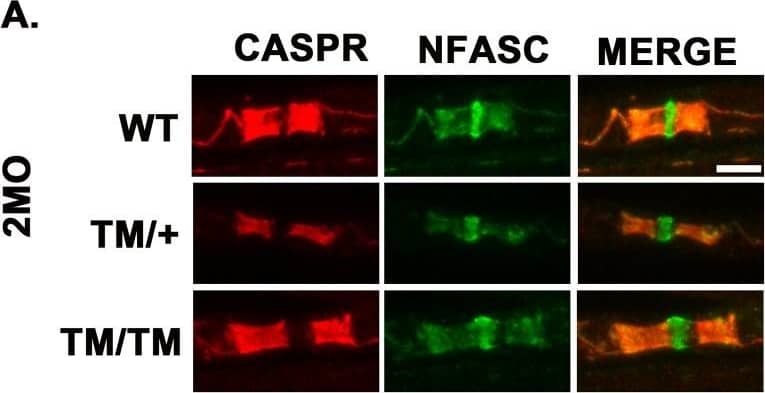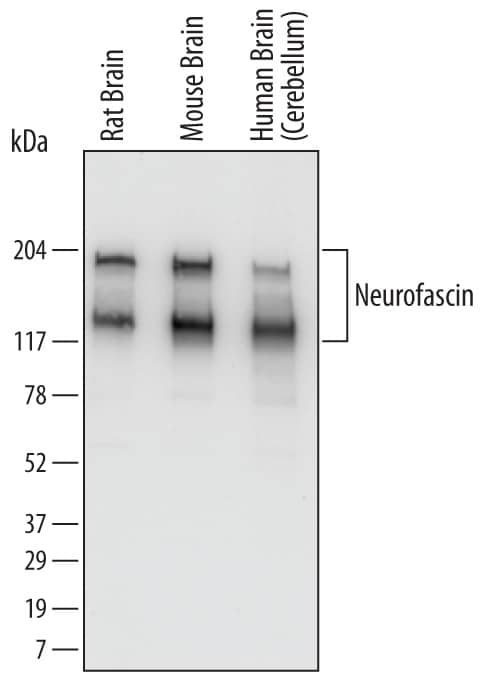Human/Mouse/Rat Neurofascin Antibody
R&D Systems, part of Bio-Techne | Catalog # AF3235

Key Product Details
Species Reactivity
Validated:
Cited:
Applications
Validated:
Cited:
Label
Antibody Source
Product Specifications
Immunogen
Ile25-Ala1031
Accession # NP_446361
Specificity
Clonality
Host
Isotype
Scientific Data Images for Human/Mouse/Rat Neurofascin Antibody
Detection of Human, Mouse, and Rat Neurofascin by Western Blot.
Western blot shows lysates of rat brain tissue, mouse brain tissue, and human brain (cerebellum). PVDF Membrane was probed with 0.1 µg/mL of Chicken Anti-Human/Mouse/Rat Neurofascin Antigen Affinity-purified Polyclonal Antibody (Catalog # AF3235) followed by HRP-conjugated Anti-Chicken IgY Secondary Antibody. Specific bands were detected for Neurofascin at approximately 140 and186 kDa (as indicated). This experiment was conducted under reducing conditions and using Immunoblot Buffer Group 1.Neurofascin in Rat Brain.
Neurofascin was detected in perfusion fixed frozen sections of rat brain (dorsal root ganglion) using Chicken Anti-Human/Mouse/Rat Neurofascin Antigen Affinity-purified Polyclonal Antibody (Catalog # AF3235) at 1.7 µg/mL overnight at 4 °C. Tissue was stained using the NorthernLights™ 557-conjugated Anti-Chicken IgY Secondary Antibody (yellow; Catalog # NL016) and counterstained with DAPI (blue). Specific staining was localized to neuronal cell bodies and Schwann cells (perinodal regions). View our protocol for Fluorescent IHC Staining of Frozen Tissue Sections.Detection of Mouse Neurofascin by Immunohistochemistry
P0T124M mutation alters SLI morphology, length,&distribution. (D) Quantification shows an increased %age of SLIs in nerves from mice harboring the P0T124M mutation (MpzT124M) at 2, 6, 12,&18 months of age. One-way ANOVA [2 month old: F (2, 10) = 29.86, p<0.0001; 6 month old: F (2, 9) = 41.60, p<0.0001, 12 month old: F (2, 6) = 34.35, p = 0.0005; 18 month old: F (2, 8) = 21.71, p = 0.0006]. Representative confocal pictures of sciatic teased fibers stained with FITC-phalloidin (ACTIN, green) (E, I,&M) or anti-MAG antibodies (Q) (green)&anti-pan-NFASC antibodies (red) at 2 (E), 6 (I),&12 (M&Q) months of age. SLI morphology is disrupted in MpzT124M mice. Scale bar: 10 μm. Measurements of SLI length at 2 (F), 6 (J),&12 (N&R) months of age. Nested one-way ANOVA [2 month old: F (2,9) = 32.16, p <0.0001; 6 month old: F (2,6) = 11.18, p = 0.0095 12 month old: F (2,9) = 6.447, p = 0.0183]. Measurements of the distance between adjacent SLI at 2 (G), 6 (K),&12 (O&S) months of age. Nested one-way ANOVA [2 month old: F (2,9) = 24.90, p = 0.0002; 6 month old: F (2,6) = 9.382, p = 0.0142; 12 month old: F (2,9) = 13.04, p = 0.0022]. Quantifications of SLI number per 100 μm at 2 (H), 6 (L),&12 (P&T) months of age. Nested one-way ANOVA [2 month old: F (2,9) = 20.29, p = 0.0005; 6 month old: F (2,6) = 22.81, p = 0.016; 12 month old: F (2,9) = 28.25, p = 0.0001]. At least 207 SLI per genotype quantified at each time point. n (animals) ≥ 3 per genotype. *p < 0.05, **p < 0.01, ***p < 0.001 by multiple-comparisons Tukey’s post hoc tests after Nested one-way ANOVA (D, F, G, H, J, K, L, R, S,&T) or by two-tailed Student’s t test (N, O,&P). Graphs indicate means ± SEMs. Image collected & cropped by CiteAb from the following open publication (https://pubmed.ncbi.nlm.nih.gov/36350884), licensed under a CC-BY license. Not internally tested by R&D Systems.Applications for Human/Mouse/Rat Neurofascin Antibody
Immunohistochemistry
Sample: Perfusion fixed frozen sections of rat brain (dorsal root ganglion)
Western Blot
Sample: Rat brain tissue, mouse brain tissue, and human brain (cerebellum) tissue
Reviewed Applications
Read 1 review rated 5 using AF3235 in the following applications:
Formulation, Preparation, and Storage
Purification
Reconstitution
Formulation
Shipping
Stability & Storage
- 12 months from date of receipt, -20 to -70 °C as supplied.
- 1 month, 2 to 8 °C under sterile conditions after reconstitution.
- 6 months, -20 to -70 °C under sterile conditions after reconstitution.
Background: Neurofascin
Neurofascin 155 (NF155) is a type I transmembrane glycoprotein that belongs to the L1CAM family of cell adhesion proteins (1, 2). The rat NF155 cDNA encodes a 1240 amino acid (aa) precursor that contains a 24 aa signal sequence, a 1086 aa extracellular domain (ECD), a 21 aa transmembrane segment, and a 109 aa cytoplasmic domain. The ECD consists of six Ig-like domains and four fibronectin type III repeats, the second of which has an RGD motif. A splice variant of Neurofascin, NF186, lacks the RGD-containing fibronectin type III domain but instead has a mucin-like domain and an additional non-RGD fibronectin type III domain (3). Within shared regions of the ECD, rat NF155 shares 45% and 39% aa sequence identity with rat Nr-CAM and L1CAM, respectively, and 98% aa sequence identity with human and mouse NF155. NF155 is transiently expressed by oligodendrocytes at the onset of axon myelination, whereas NF186 is neuronally expressed in nodes of Ranvier (4‑6). Clustering of NF155 in paranodal oligodengroglia lipid raft domains is stabilized by dimerization of its cytoplasmic domains and association with intracellular ankyrin (6‑9). NF155 interacts with axonal contactin and plays a role in node of Ranvier formation and the establishment of saltatory conduction (5, 9‑12). The ECD of NF155 is cleaved from oligodengroglia membranes by metalloproteases, a process which is required for NF155 transport from the glial cell body to the axoglial junction (13). In addition to distinct expression patterns, Neurofascin isoforms have different functional properties. NF155 promotes neuronal adhesion and neurite outgrowth, whereas NF186 inhibits neuronal adhesion (4, 7, 13).
References
- Sherman, D.L. and P.J. Brophy (2005) Nat. Rev. Neurosci. 6:683.
- Coman, I. et al. (2005) J. Neurol. Sci. 233:67.
- Volkmer, H. et al. (1992) J. Cell Biol. 118:149.
- Koticha, D. et al. (2005) Mol. Cell. Neurosci. 30:137.
- Collinson, J.M. et al. (1998) Glia 23:11.
- Schafer, D.P. et al. (2004) J. Neurosci. 24:3176.
- Maier, O. et al. (2005) Mol. Cell. Neurosci. 28:390.
- Zhang, X. et al. (1998) J. Biol. Chem. 273:30785.
- Sherman, D.L. et al. (2005) Neuron 48:737.
- Gollan, L. et al. (2003) J. Cell Biol. 163:1213.
- Charles, P. et al. (2002) Curr. Biol. 12:217.
- Volkmer, H. et al. (1996) J. Cell Biol. 135:1059.
- Maier, O. et al. (2006) Exp. Cell Res. 312:500.
Alternate Names
Gene Symbol
UniProt
Additional Neurofascin Products
Product Documents for Human/Mouse/Rat Neurofascin Antibody
Product Specific Notices for Human/Mouse/Rat Neurofascin Antibody
For research use only



